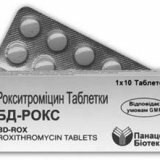Macrolides, their advantages and disadvantages
 Macrolides are one of the classes of antibiotics that distinguish their chemical structure, which is based on a macrocyclic lactone ring. Now we want to describe the class of macrolide preparations - their shortcomings and advantages.
Macrolides are one of the classes of antibiotics that distinguish their chemical structure, which is based on a macrocyclic lactone ring. Now we want to describe the class of macrolide preparations - their shortcomings and advantages.
Based on the number of carbon atoms present in the ring is divided into data antibiotics:
- 14-membered, which include clarithromycin, erythromycin, roxithromycin, etc.,
- 15-membered, which include azithromycin,
- 16-..five-membered, these include josamycin, midecamycin, spiramycin, etc.
main( valuable) clinical feature of this group of drugs is their activity against intracellular pathogens, such as:.. Legionella, chlamydia, mycoplasma, campylobacter, and againstTo gram-positive cocci. Macrolides are among the least toxic group of antibiotics.
addition to the foregoing macrolide also include:
- azalides - are substances which are fifteen membered macrocyclic structure that is obtained by inclusion of the nitrogen atom in a fourteen membered lactone ring, the nitrogen atom located between 9 and 10 carbon atoms in the ring,
- ketolides - soCalled fourteen member macrolides with an attached keto group to the third carbon atom.
Also to this group of antibiotics include nominally tacrolimus formulation, which applies to immunosuppressants, its chemical structure is composed of twenty-three membered lactone ring.
Classification of macrolides and their properties.
Depending on ways of getting this group of antibiotics is divided into several groups:
1. Natural, these include:
- erythromycin and oleandomycin, consisting of fourteen membered lactone ring,
- midecamycin, leucomycin, josamycin and spiramycin, which consist of sixteen membered lactonerings.
2. Prodrugs, which include:
- salts of erythromycin, more specifically succinate, ascorbate, phosphate, stearate,
- esters of erythromycin, more specifically ethylsuccinate, propionyl,
- esters of oleandomycin, more specifically trolandomycin,
- salts of erythromycin esters, more precisely, acidrite, Acetylcysteinate, propionyl mercaptosuccinate, estolate,
- salts of oleandomycin, more precisely phosphate and hydrochloride.
All of the above substances are characterized by a fourteen-membered lactone ring.
3. Semi-synthetic, and include:
- telithromycin, in turn related to the ketolides, dirithromycin, roxithromycin, fluritromitsin, clarithromycin. These drugs consist of a fourteen-membered lactone ring.
- azithromycin, consisting of a fifteen-membered lactone ring.
- Rokitamycin, consisting of a sixteen-membered lactone ring.
Common properties possessed by all species of macrolide, and in which are shown their advantages over other types of drugs include:
- low toxicity,
- high concentration in tissues,
- bacteriostatic effect on fabric,
- activity directed against intracellular pathogens, and againstGram-positive cocci,
- do not cross-allergic to β-lactams when used.
Antimicrobial effect, which is achieved with the use of macrolides, arises because there is a violation of protein synthesis in microbial cells. Often, this type of antibiotic is peculiar to the provision of bacteriostatic action, but at a high concentration they are also able to affect the causative agents of diphtheria and pertussis, and pneumococcus. In addition to antibacterial action, these antibiotics are characterized by immunomodulatory and moderate anti-inflammatory activity.
These antibiotics are classified as tissue, due to the fact that their concentration in the blood is several times less than in the tissues. Different types of macrolides bind differently to proteins in the blood plasma, those that have the greatest connectivity are actively distributed in the body and create a high concentration in tissues and organs, penetrating into the cells, creating a high intracellular concentration.
Advantages and disadvantages.
Macrolides, their advantages and disadvantages have been largely studied, this type of antibiotics is the safest, which is their advantage, but there are also disadvantages, which include mainly contraindications and some side effects that these drugs can cause.
These side effects include:
- In the treatment of the gastrointestinal tract, pain and discomfort in the abdomen, the occurrence of nausea, vomiting and diarrhea can occur, this reaction most often causes erythromycin, which has a prokinetic effect, less often this reaction is characteristic of spiramycin and josamycin.
- In case of liver disease, there may be a transient increase in activity, cholestatic hepatitis, which can manifest as jaundice, fever, weakness, abdominal pain, nausea and vomiting that may occur with the use of erythromycin and clarithromycin, much less so the body responds to spiramycinAnd josamycin.
- There may also be a reaction to the central nervous system, with a headache, dizziness, hearing problems that occur very rarely, but the possibility is there.
- It is also possible the occurrence of an allergic reaction in the form of a rash or hives.
This type of antibiotic is indicated for:
- upper respiratory tract infections, for example acute sinusitis, streptococcal tonsillopharyngitis,
- lower respiratory tract infections, for example in community-acquired pneumonia or exacerbation of chronic bronchitis,
- with pertussis,
- for diphtheria,
- for skin infections andSoft tissue,
- for sexually transmitted infections,
- for oral infections,
- for severe acne,
- for campylobacter gastroenteritis,
- for toxoplasmOz,
- for cryptosporidiosis,
- in the prevention and treatment of mycobacteriosis.
Macrolide preparations are already well known; therefore, they are also used for preventive purposes, if there is a potential danger of getting pertussis if there was contact with the patient, in the prevention of rheumatism, allergic reactions to penicillin, etc.



